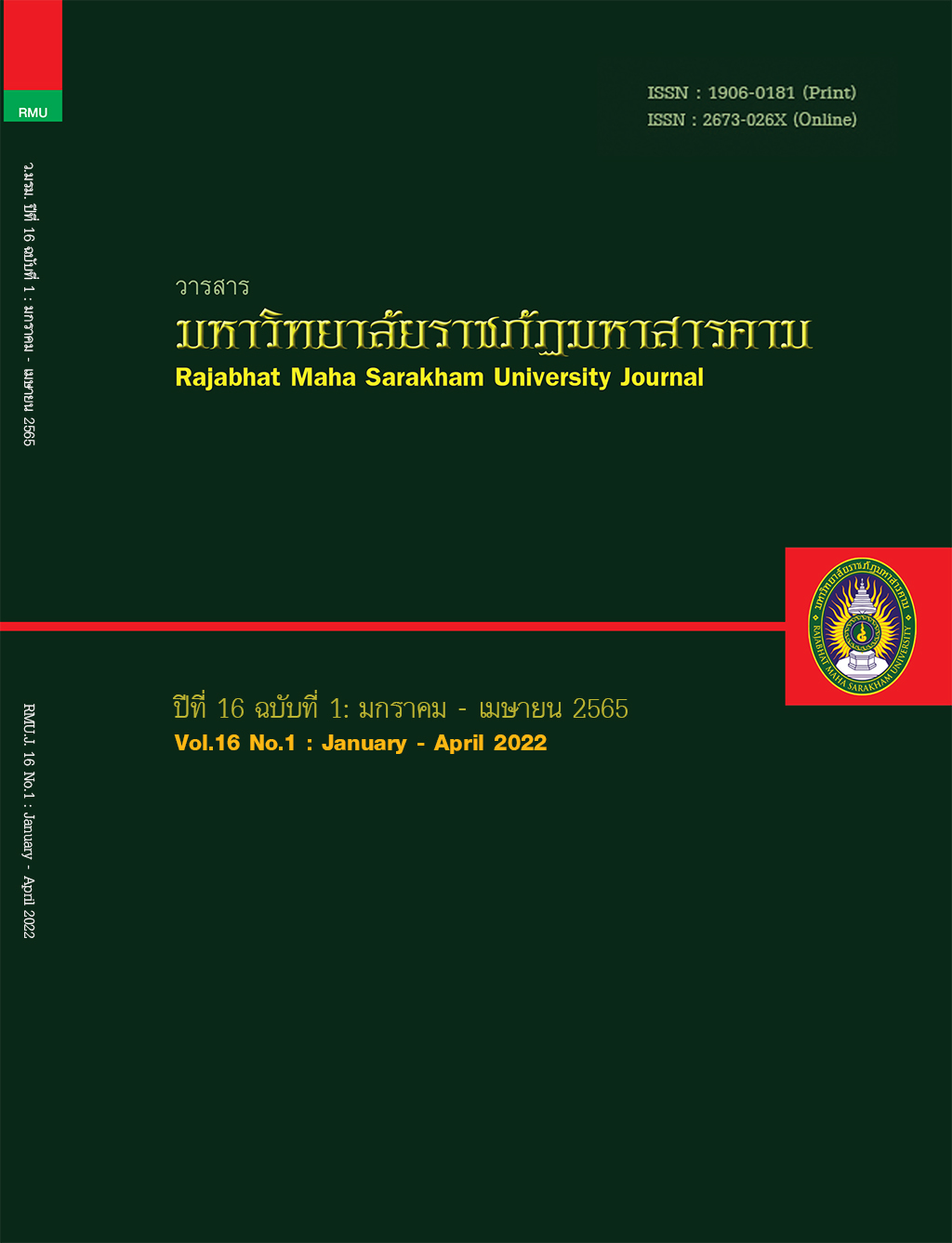การพัฒนากิจกรรมการเรียนรู้คณิตศาสตร์ตามแนวคิดการเรียนรู้โดยใช้ปัญหาเป็นฐาน (PBL) เรื่องการแก้โจทย์ปัญหาเศษส่วนสำหรับนักเรียนชั้นประถมศึกษาปีที่ 5
Main Article Content
บทคัดย่อ
การวิจัยนี้มีวัตถุประสงค์เพื่อ 1) พัฒนากิจกรรมการเรียนรู้คณิตศาสตร์ ตามแนวคิดการเรียนรู้โดยใช้ปัญหาเป็นฐาน (PBL) เรื่อง การแก้โจทย์ปัญหาเศษส่วน สำหรับนักเรียนชั้นประถมศึกษาปีที่ 5 ให้มีประสิทธิภาพ 75/75 2) เปรียบเทียบผลสัมฤทธิ์ทางการเรียนหลังเรียนของนักเรียนกลุ่มที่ได้รับการจัดกิจกรรมการเรียนรู้คณิตศาสตร์ตามแนวคิดการเรียนรู้โดยใช้ปัญหาเป็นฐาน (PBL) เรื่อง การแก้โจทย์ปัญหาเศษส่วน สำหรับนักเรียนชั้นประถมศึกษาปีที่ 5และ 3) ศึกษาความพึงพอใจของนักเรียนนักเรียนชั้นประถมศึกษาปีที่ 5 ที่มีต่อการจัดกิจกรรมการเรียนรู้กลุ่มตัวอย่างได้แก่ นักเรียนชั้นประถมศึกษาปีที่ 5 โรงเรียนดงเกลือวิทยา จำนวน 7 คน ได้มาโดยการเลือกแบบเจาะจง เครื่องมือที่ใช้ ได้แก่ 1) แผนการจัดการเรียนรู้เรื่อง การแก้โจทย์ปัญหาเศษส่วน จำนวน 5 แผนใช้เวลา 15 ชั่วโมง 2) แบบทดสอบวัดผลสัมฤทธิ์ทางการเรียนแบบปรนัย 4 ตัวเลือก จำนวน 20 ข้อมีค่าอำนาจจำแนกอยู่ระหว่าง 0.31 – 0.77 และมีค่าความเชื่อมั่น 0.72 และ 3) แบบสอบถามวัดความพึงพอใจมีค่าอำนาจจำแนกตั้งแต่ .35 - .73สถิติที่ใช้ ได้แก่ ค่าร้อยละ ค่าเฉลี่ยและส่วนเบี่ยงเบนมาตรฐาน การทดสอบสมมติฐานโดยใช้ t - test
ผลการวิจัยพบว่า 1) กิจกรรมการเรียนรู้คณิตศาสตร์ตามแนวคิดการเรียนรู้โดยใช้ปัญหาเป็นฐาน (PBL) เรื่องการแก้โจทย์ปัญหาเศษส่วน สำหรับนักเรียนชั้นประถมศึกษาปีที่ 5 มีประสิทธิภาพเท่ากับ 74.63/79.37ซึ่งสูงกว่าเกณฑ์ที่กำหนดไว้2) ผลการเปรียบเทียบผลสัมฤทธิ์ทางการเรียนหลังเรียนของนักเรียนกลุ่มที่ได้รับการจัดกิจกรรมการเรียนรู้คณิตศาสตร์ตามแนวคิดการเรียนรู้โดยใช้ปัญหาเป็นฐาน (PBL) เรื่อง การแก้โจทย์ปัญหาเศษส่วน พบว่า คะแนนผลสัมฤทธิ์ทางการเรียนหลังเรียนสูงกว่าก่อนเรียนอย่างมีนัยสำคัญทางสถิติที่ระดับ .05 และ 3) นักเรียนชั้นประถมศึกษาปีที่ 5 มีความพึงพอใจต่อการจัดกิจกรรมการเรียนรู้คณิตศาสตร์ตามแนวคิดการเรียนรู้โดยใช้ปัญหาเป็นฐาน (PBL) เรื่อง การแก้โจทย์ปัญหาเศษส่วน อยู่ในระดับมาก(= 4.55, S.D. = 0.34)
Article Details

อนุญาตภายใต้เงื่อนไข Creative Commons Attribution-NonCommercial-NoDerivatives 4.0 International License.
1. บทความที่ลงตีพิมพ์ทุกเรื่องได้รับการตรวจทางวิชาการโดยผู้ประเมินอิสระ ผู้ทรงคุณวุฒิ (Peer Review) สาขาที่เกี่ยวข้อง อย่างน้อย 3 ท่าน ในรูปแบบ Double blind review
2. ข้อคิดเห็นใด ๆ ของบทความที่ลงตีพิมพ์ในวารสารมหาวิทยาลัยราชภัฏมหาสารคาม นี้เป็นของผู้เขียน คณะผู้จัดทำวารสารไม่จำเป็นต้องเห็นด้วย
3. กองบรรณาธิการวารสารมหาวิทยาลัยราชภัฏมหาสารคาม ไม่สงวนสิทธิ์การคัดลอกแต่ให้อ้างอิงแสดงที่มา
เอกสารอ้างอิง
กรมวิชาการ. (2545).การจัดสาระการเรียนรู้กลุ่มสาระการเรียนรู้การงานอาชีพและเทคโนโลยีตามหลักสูตรการศึกษาขั้นพื้นฐาน พุทธศักราช 2544. กรุงเทพฯ : โรงพิมพ์องค์การรับส่งสินค้าและพัสดุภัณฑ์ (ร.ส.พ.).
กระทรวงศึกษาธิการ. (2549). แนวทางการดำเนินงานปฏิรูปการเรียนการสอน ตามเจตนารมณ์กระทรวงศึกษาธิการ2549 ปีแห่งการปฏิรูปการเรียนการสอน. กรุงเทพฯ:สำนักวิชาการและมาตรฐาน
กระทรวงศึกษาธิการ. (2552).หลักสูตรการศึกษาขั้นพื้นฐาน พุทธศักราช 2551. กรุงเทพฯ :โรงพิมพ์คุรุสภาลาดพร้าว.
ฉัตรลดา ปุณณขันธ์. (2548). การพัฒนาแผนการจัดการเรียนรู้แบบบูรณาการเรื่องเพลงไทย กลุ่มสาระการเรียนรู้ศิลปะ ชั้นประถมศึกษาบีที่ 4.การศึกษามหาบัณฑิต.มหาสารคาม : มหาวิทยาลัยมหาสารคาม.
บุญชม ศรีสะอาด. (2552). การวิจัยเกี่ยวกับการบริหารการศึกษา.กรุงเทพฯ : สุวิริยาสาส์น.
บุญชม ศรีสะอาด. (2545). การวิจัยเบื้องต้น (พิมพ์ครั้งที่ 7). กรุงเทพฯ: สุวีริยาสาส์น.
ประภาศิริ ปราโมทย์. (2561). การพัฒนาชุดกิจกรรมการเรียนรู้คณิตศาสตร์โดยใช้รูปแบบการเรียนรู้แบบร่วมมือควบคู่กับเกม เพื่อส่งเสริมผลการเรียนรู้และคุณลักษณะที่พึงประสงค์ทางคณิตศาสตร์สำหรับนักเรียนชั้นประถมศึกษาปีที่ 5. ครุศาสตรมหาบัณฑิต สาขาวิชาหลักสูตรและการสอน. เชียงใหม่ : มหาวิทยาลัยราชภัฏเชียงใหม่.
เผชิญ กิจระการ. การวิเคราะห์ประสิทธิภาพสื่อและเทคโนโลยีเพื่อการศึกษา (E1/E2).วัดผลการศึกษา. 2(2) : 25-29.
มัณฑรา ธรรมบุศย์. (2545). การพัฒนาคุณภาพการเรียนรู้โดยใช้ PBL (Problem-Based Learning). วารสารวิชาการ 5(1), 11-27.
รัตนะ บัวสนธ์. (2552). วิจัยเชิงคุณภาพทางการศึกษา. กรุงเทพมหานคร : จุฬาลงกรณ์มหาวิทยาลัย.
โรงเรียนดงเกลือวิทยา. (2560). รายงานการเรียนการสอนคณิตศาสตร์ ปีการศึกษา 2560. ร้อยเอ็ด: โรงเรียนดงเกลือวิทยา.
สร้อยตระกูล ติวยานนท์. (2542). พฤติกรรมองค์การ : ทฤษฎีและการประยุกต์ (พิมพ์ครั้งที่ 2). กรุงเทพฯ : สำนักพิมพ์หาวิทยาลัยธรรมศาสตร์.
สิริพร ทิพย์คง. (2545). หลักสูตรและการสอนคณิตศาสตร์ (พิมพ์ครั้งที่ 1). กรุงเทพฯ: บริษัท พัฒนาคุณภาพวิชาการ(พว.) จำกัด.
สมาคมคณิตศาสตร์แห่งประเทศไทยในพระบรมราชูปถัมภ์. (2543).คู่มือโครงงานคณิตศาสตร์.กรุงเทพฯ: บพิธการพิมพ์.


